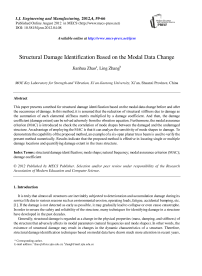Structural Damage Identification Based on the Modal Data Change
Автор: Jianhua Zhao, Ling Zhang
Журнал: International Journal of Engineering and Manufacturing(IJEM) @ijem
Статья в выпуске: 4 vol.2, 2012 года.
Бесплатный доступ
This paper presents a method for structural damage identification based on the modal data change before and after the occurrence of damage. In this method, it is assumed that the reduction of structural stiffness due to damage as the summation of each elemental stiffness matrix multiplied by a damage coefficient. And then, the damage coefficient (damage extent) can be solved adversely from the vibration equation. Furthermore, the modal assurance criterion (MAC) is introduced to check the correlation of mode shapes between the damaged and the undamaged structure. An advantage of employing the MAC is that it can analyze the sensitivity of mode shapes to damage. To demonstrate the capability of the proposed method, an example of a six-span planar truss beam is used to verify the present method numerically. Results indicate that the proposed method is effective in locating single or multiple damage locations and quantifying damage extent in the truss structure.
Structural damage identification, mode shape, natural frequency, modal assurance criterion (MAC), damage coefficient
Короткий адрес: https://sciup.org/15014325
IDR: 15014325
Список литературы Structural Damage Identification Based on the Modal Data Change
- Y. Xia and H. Hao, “Statistical damage identification of structures with frequency changes,” Journal of Sound and Vibration, vol. 263, pp. 853–870, 2003.
- O. S. Salawu, “Detection of structural damage through changes in frequency: a review,” Engineering Structures, vol. 19, no. 9, pp.718–723, Sep 1997.
- N. Bicanic and H. P. Chen, “Damage identification in framed structures using natural frequencies,” International Journal for Numerical methods in Engineering, vol. 40, pp. 4451–4468, Feb 1997.
- S. Chinchalkar, “Determination of crack location in beams using natural frequencies,” Journal of Sound and Vibration, vol. 247, no. 3, pp. 417–429, March 2001.
- J. T. Kim, Y. S. Ryu, H. M. Cho, and N. Stubbs, “Damage identification in beam-type structures: frequency-based method vs mode-shape-based method,” Engineering Structures, vol. 25, pp. 57–67, 2003.
- H. Ahmadian, J. E. Mottershead, and M. I. Friswell, “Damage location indicators from substructure mode shapes,” Inverse Problems in Science and Engineering, vol. 8, no. 4, pp. 309–323, Apr 2000.
- W. X. Ren and G. D. Roeck, “Structural damage identification using modal data. I: simulation verification,” Journal of Structural Engineering, ASCE, vol. 128, no. 1, pp. 87–95, Jan 2002.
- W. X. Ren and G. D. Roeck, “Structural damage identification using modal data. II: test verification,” Journal of Structural Engineering, ASCE, vol. 128, no. 1, pp. 96–104, Jan 2002.
- Z. Y. Shi, S. S. Law, and L. M. Zhang, “Structural damage detection from modal strain energy change,” Journal of Engineering Mechanics, ASCE, Vol. 126, no. 12, pp.1216-1223, December 2000.
- J. F. Wang, C. C. Lin, and S. M. Yen, “A story damage index of seismically-excited buildings based on modal frequency and mode shape,” Engineering Structures, Vol. 29, pp.2143-2157, 2007.
- R. J. Allemang and D. L. Brown, “A correlation coefficient for modal vector analysis,” Proceedings of the first international modal analysis conference, Orlando, FL, pp. 110–116, 1982.


